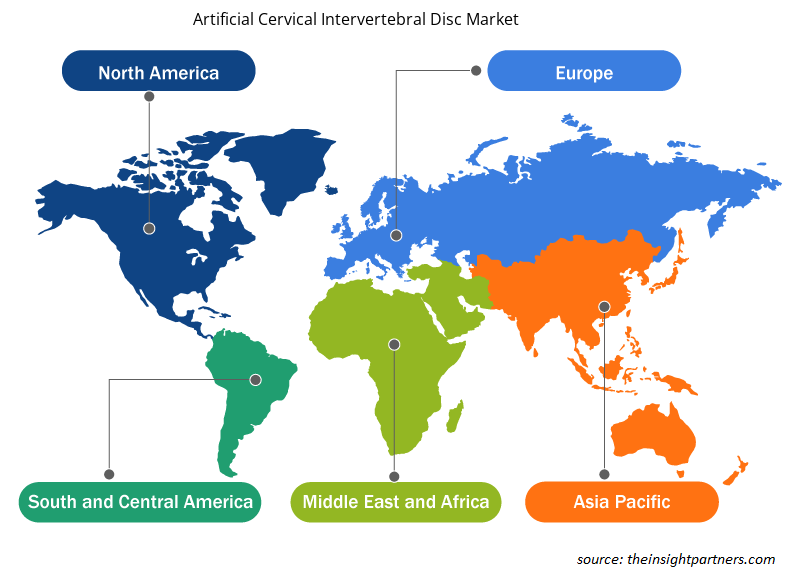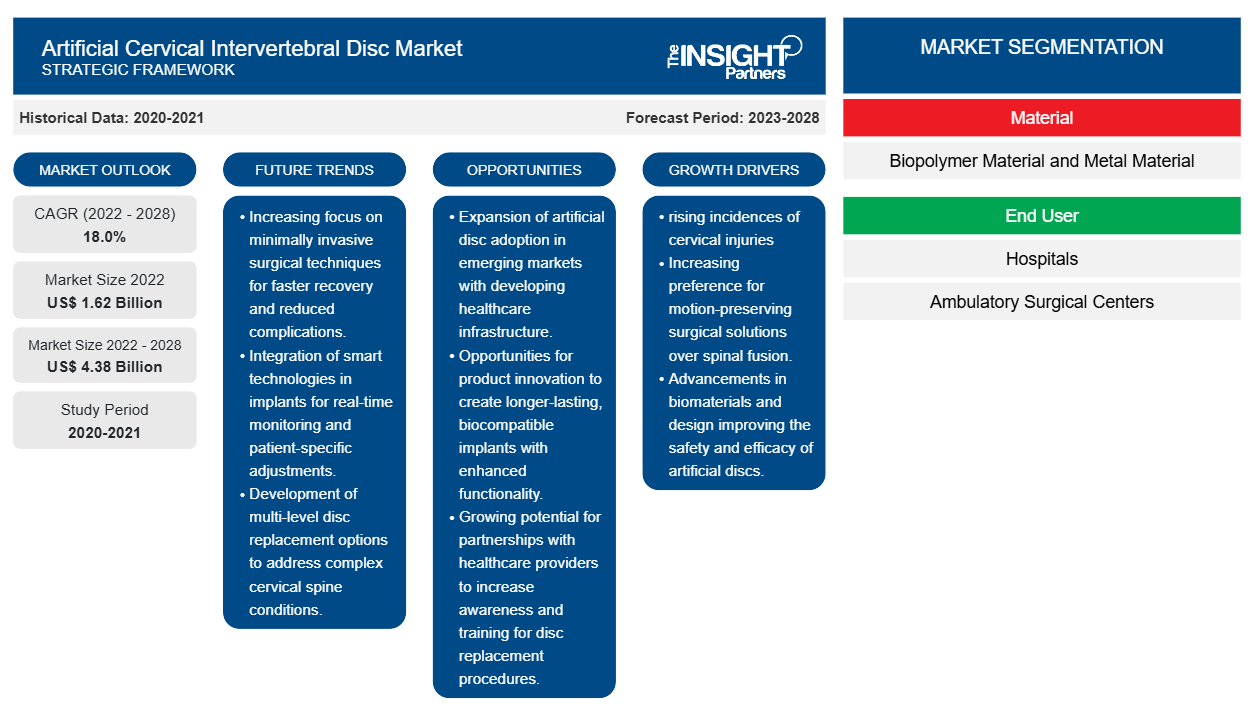[Informe de investigación] Se espera que el tamaño del mercado de discos intervertebrales cervicales artificiales crezca de US$ 1.621,66 millones en 2022 a US$ 4.375,29 millones en 2028; se estima que crecerá a una CAGR del 18,0% entre 2022 y 2028.
El crecimiento del mercado de discos intervertebrales cervicales artificiales se atribuye a la creciente prevalencia de lesiones cervicales. Los traumatismos son la principal causa de lesiones cervicales, incluidos accidentes de tráfico, traumatismos penetrantes o contundentes, caídas y lesiones deportivas o de buceo. Según el estudio "Estimación del número de lesiones de la columna cervical relacionadas con accidentes de tráfico en EE. UU.: un análisis y comparación de los datos nacionales de accidentes y hospitales", publicado en 2020, en EE. UU., se observan anualmente ~869 000 lesiones de la columna cervical relacionadas con accidentes de tráfico en los hospitales, de las cuales ~841 000 son lesiones por esguince/distensión (latigazo cervical), 2800 son lesiones de disco espinal, 23 500 son fracturas, 2800 son lesiones de la médula espinal y 1500 dislocaciones. Además, la mayoría de las lesiones deportivas son lesiones ortopédicas, que incluyen distensiones, esguinces, fracturas, ligamentos rotos, dolor e hinchazón; estas pueden ser agudas o crónicas. Según Stanford Children's Health, aproximadamente 30 millones de jóvenes y niños en los EE. UU. practican deportes anualmente, y cada año se informan más de 3,5 millones de lesiones relacionadas con el deporte. Una fractura cervical es el resultado de un traumatismo de alta energía, como una caída en gimnasia, hockey, fútbol o buceo. La incidencia de fracturas es alta en los atletas. Según Spinal Cord Injury Facts and Figures at a Glance, 2020, en los EE. UU., aproximadamente el 7,8 % del total de lesiones de la médula espinal (LME) se deben a los deportes. Según la Comisión de Seguridad de Productos para el Consumidor de EE. UU. (CPSC), en 2018, se trataron aproximadamente 23 720 fracturas de cuello en las salas de emergencia de los hospitales de EE. UU.; de estas, aproximadamente 3194 fracturas se debieron a los deportes. La incidencia de lesiones deportivas aumenta con el aumento de la participación en deportes y la participación activa en actividades de acondicionamiento físico debido al creciente enfoque en la vida saludable en todo el mundo. Además, según el Centro Nacional de Estadísticas de Lesiones de la Médula Espinal, el buceo es la quinta causa principal de lesión grave de la médula espinal cervical. Por lo tanto, la demanda de discos intervertebrales cervicales artificiales está aumentando debido a la creciente incidencia de lesiones cervicales.
El disco intervertebral cervical tiene la capacidad de absorber una enorme carga de compresión al tiempo que proporciona diferentes tipos de movimiento entre los huesos del cuello. Los actores del mercado han desarrollado varios discos intervertebrales cervicales artificiales que se utilizan para tratar problemas de disco cervical. El disco cervical artificial reemplaza la función de movimiento y amortiguación del disco cervical dañado.
Personalice este informe según sus necesidades
Obtendrá personalización en cualquier informe, sin cargo, incluidas partes de este informe o análisis a nivel de país, paquete de datos de Excel, así como también grandes ofertas y descuentos para empresas emergentes y universidades.
- Obtenga las principales tendencias clave del mercado de este informe.Esta muestra GRATUITA incluirá análisis de datos, desde tendencias del mercado hasta estimaciones y pronósticos.
Perspectivas del mercado
El aumento de la población geriátrica impulsa el mercado de los discos cervicales intervertebrales artificiales
El proceso de envejecimiento afecta la columna cervical, el cuello, los hombros, la parte superior de la espalda y los brazos. La espondilosis cervical es un término que se refiere al desgaste de los discos espinales del cuello relacionado con la edad. Es una enfermedad común y empeora con la edad. Según la Academia Estadounidense de Cirujanos Ortopédicos, aproximadamente el 85 % de las personas mayores de 60 años padecen espondilosis cervical. Con la edad, los discos vertebrales, que sirven como amortiguadores, se secan gradualmente y afectan la resistencia. Según la Hoja informativa: Envejecimiento en los Estados Unidos, se estima que el número de personas de 65 años o más llegará a aproximadamente 95 millones para 2060, frente a los 52 millones de 2018, y es probable que su proporción en la población total aumente hasta el 23 % desde el 16 %. Además, según el informe “Later Life in the UK 2019 - Age UK”, aproximadamente 12 millones (11.989.322) de personas tienen 65 años o más en el Reino Unido, de las cuales 5,4 millones tienen 75 años o más y 1,6 millones tienen 85 años. Además, Japón es otra nación en proceso de envejecimiento, con un 28,7% de su población con 65 años o más. La sociedad “superenvejecida” del país es la más antigua del mundo. Por lo tanto, es probable que el creciente envejecimiento de la población aumente la demanda de discos intervertebrales cervicales artificiales.
Perspectivas basadas en materiales
En función del material, el mercado de discos intervertebrales cervicales artificiales se ha dividido en material biopolimérico y material metálico. Es probable que el segmento de material biopolimérico tenga una mayor participación en el mercado en 2022, el crecimiento se atribuye principalmente a la biocompatibilidad y la facilidad de inserción que ofrecen los discos de material biopolimérico. Sin embargo, se prevé que el segmento de material metálico registre una mayor CAGR en el mercado durante 2022-2028.
Los actores del mercado de discos intervertebrales cervicales artificiales adoptan estrategias orgánicas, como el lanzamiento y la expansión de productos, para expandir su presencia y su cartera de productos a nivel mundial y satisfacer la creciente demanda. Los desarrollos de las empresas en el mercado global de discos intervertebrales cervicales artificiales se han caracterizado como desarrollos orgánicos e inorgánicos. Las estrategias de crecimiento orgánico adoptadas por los actores del mercado incluyen el lanzamiento y la expansión de productos. Las estrategias de crecimiento inorgánico observadas en el mercado de discos intervertebrales cervicales artificiales fueron asociaciones y colaboraciones. Estas estrategias de crecimiento han permitido a los actores del mercado expandir sus negocios y mejorar su presencia geográfica. Además, las estrategias de crecimiento como adquisiciones y asociaciones ayudaron a fortalecer la base de clientes de la empresa y aumentar su cartera de productos. Los desarrollos orgánicos representan el 80,95% de los desarrollos estratégicos totales en el mercado, mientras que las estrategias inorgánicas representan el 19,05% del crecimiento de las empresas.
El mercado de discos intervertebrales cervicales artificiales se ha segmentado de la siguiente manera:
El mercado de discos intervertebrales cervicales artificiales está segmentado en función del material y del usuario final. Según el material, el mercado se divide en biopolímeros y metales. El mercado global de discos intervertebrales cervicales artificiales, según el usuario final, está segmentado en hospitales, centros quirúrgicos ambulatorios y otros.
Perspectivas regionales del mercado de discos intervertebrales cervicales artificiales
Los analistas de Insight Partners explicaron en detalle las tendencias y los factores regionales que influyen en el mercado de discos intervertebrales cervicales artificiales durante el período de pronóstico. Esta sección también analiza los segmentos y la geografía del mercado de discos intervertebrales cervicales artificiales en América del Norte, Europa, Asia Pacífico, Oriente Medio y África, y América del Sur y Central.

- Obtenga datos regionales específicos para el mercado de discos intervertebrales cervicales artificiales
Alcance del informe de mercado de discos intervertebrales cervicales artificiales
| Atributo del informe | Detalles |
|---|---|
| Tamaño del mercado en 2022 | 1.620 millones de dólares estadounidenses |
| Tamaño del mercado en 2028 | US$ 4.38 mil millones |
| CAGR global (2022-2028) | 18,0% |
| Datos históricos | 2020-2021 |
| Período de pronóstico | 2023-2028 |
| Segmentos cubiertos | Por material
|
| Regiones y países cubiertos | América del norte
|
| Líderes del mercado y perfiles de empresas clave |
|
Densidad de actores del mercado de discos intervertebrales cervicales artificiales: comprensión de su impacto en la dinámica empresarial
El mercado de discos intervertebrales cervicales artificiales está creciendo rápidamente, impulsado por la creciente demanda de los usuarios finales debido a factores como la evolución de las preferencias de los consumidores, los avances tecnológicos y una mayor conciencia de los beneficios del producto. A medida que aumenta la demanda, las empresas amplían sus ofertas, innovan para satisfacer las necesidades de los consumidores y aprovechan las tendencias emergentes, lo que impulsa aún más el crecimiento del mercado.
La densidad de actores del mercado se refiere a la distribución de las empresas o firmas que operan dentro de un mercado o industria en particular. Indica cuántos competidores (actores del mercado) están presentes en un espacio de mercado determinado en relación con su tamaño o valor total de mercado.
Las principales empresas que operan en el mercado de discos intervertebrales cervicales artificiales son:
- Compañía: Zimmer Biomet Holdings, Inc.
- Compañía Médica Globus, Inc.
- Centinela Spine, LLC
- Soluciones de columna vertebral Synergy, Inc.
- Aditus Médico
Descargo de responsabilidad : Las empresas enumeradas anteriormente no están clasificadas en ningún orden particular.

- Obtenga una descripción general de los principales actores clave del mercado de discos intervertebrales cervicales artificiales
Perfiles de empresas
- Compañía: Zimmer Biomet Holdings, Inc.
- Compañía Médica Globus, Inc.
- Centinela Spine, LLC
- Soluciones de columna vertebral Synergy, Inc.
- B. Braun Melsugen AG
- Aditus Médico
- AxioMed LLC
- NuVasive, Inc.
- Medtronic
- Análisis histórico (2 años), año base, pronóstico (7 años) con CAGR
- Análisis PEST y FODA
- Tamaño del mercado, valor/volumen: global, regional y nacional
- Industria y panorama competitivo
- Conjunto de datos de Excel
Informes recientes
Testimonios
Razón para comprar
- Toma de decisiones informada
- Comprensión de la dinámica del mercado
- Análisis competitivo
- Información sobre clientes
- Pronósticos del mercado
- Mitigación de riesgos
- Planificación estratégica
- Justificación de la inversión
- Identificación de mercados emergentes
- Mejora de las estrategias de marketing
- Impulso de la eficiencia operativa
- Alineación con las tendencias regulatorias





















 Obtenga una muestra gratuita para - Mercado de discos intervertebrales cervicales artificiales
Obtenga una muestra gratuita para - Mercado de discos intervertebrales cervicales artificiales